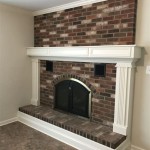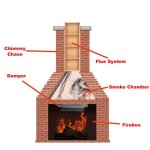Cleaning Soot From a Stone Fireplace
A stone fireplace adds a touch of rustic elegance and warmth to any home. However, the frequent use of a fireplace results in the inevitable buildup of soot. Soot is a black, powdery substance composed primarily of carbon particles, produced by incomplete combustion of wood. Over time, this accumulation can diminish the aesthetic appeal of the stone and, if left unattended, potentially cause health issues due to airborne particles. Therefore, routine cleaning is essential to maintain the fireplace's beauty and functionality.
The difficulty in cleaning soot from a stone fireplace lies in the porous nature of the stone itself. Unlike smooth surfaces, soot particles readily penetrate the tiny crevices and pores, making it challenging to remove them completely. The specific cleaning method must consider the type of stone used in the fireplace construction. Some stones are more delicate than others and require gentler cleaning solutions and techniques to prevent damage. Identifying the stone type is crucial before commencing any cleaning procedure.
Before beginning the cleaning process, ensure adequate protection for the surrounding area. Cover the floor and nearby furniture with drop cloths or plastic sheeting to prevent soot from spreading. Wear protective gear, including gloves, safety glasses, and a dust mask, to avoid direct contact with soot and potential irritants. Good ventilation is also critical, so open windows and doors to allow fresh air to circulate during and after cleaning.
Preparing for Soot Removal
The first step in cleaning a stone fireplace is to prepare the area and remove loose soot. Begin by using a dry brush with stiff bristles to sweep away any loose soot and debris from the surface of the stone. A vacuum cleaner with a brush attachment can be used to collect the dislodged soot, preventing it from resettling on the surrounding surfaces. Ensure the vacuum is equipped with a HEPA filter to trap fine soot particles and prevent them from being released back into the air.
Inspect the stone for any cracks or damage before applying any cleaning solutions. If damage is present, avoid using harsh chemicals that could exacerbate the problem. Consult with a professional stone restorer for advice on repairing the damage before attempting to clean the soot. The presence of moisture can also complicate the cleaning process, so ensure the stone is dry before proceeding. The fireplace should not have been recently used and should be completely cool to the touch.
A crucial aspect of preparation is testing the cleaning solution on an inconspicuous area of the stone. This allows evaluating the solution's effectiveness and ensures it will not damage or discolor the stone. Apply a small amount of the chosen cleaning solution to a hidden area and let it sit for a few minutes. Then, gently scrub the area with a brush and rinse it with clean water. Observe the area for any adverse reactions, such as discoloration, etching, or staining. If no adverse reactions are observed, the cleaning solution can be safely used on the rest of the fireplace.
Choosing a Cleaning Solution
Several cleaning solutions can be used to remove soot from a stone fireplace, ranging from mild to more aggressive options. The choice of solution depends on the severity of the soot buildup and the type of stone. For light soot accumulation, a simple solution of warm water and dish soap may suffice. This solution is gentle and less likely to damage delicate stones.
For more stubborn soot stains, a mixture of baking soda and water can be effective. Create a paste by mixing baking soda with enough water to form a thick consistency. Apply the paste to the soot-stained areas and let it sit for a few minutes before scrubbing gently with a brush. Baking soda is a mild abrasive that can help lift soot particles from the stone's surface.
In cases of heavy soot buildup, a commercial fireplace cleaner specifically designed for stone may be necessary. These cleaners typically contain stronger chemicals that can dissolve soot more effectively. When using commercial cleaners, always follow the manufacturer's instructions carefully and wear appropriate protective gear. Ensure the product is compatible with the type of stone in the fireplace to avoid damaging the surface.
Applying the Cleaning Solution and Removing Soot
Once the cleaning solution is selected, apply it to the soot-stained areas of the stone fireplace. Use a sponge or brush to evenly distribute the solution, ensuring it penetrates the pores of the stone. Allow the solution to dwell on the surface for the recommended time, as indicated by the manufacturer's instructions, or for a few minutes if using a homemade solution. This dwell time allows the solution to loosen the soot particles, making them easier to remove.
After the dwell time, use a scrub brush with firm but non-abrasive bristles to gently scrub the soot-stained areas. Avoid using excessive force, as this could damage the stone's surface. Work in small sections, focusing on the areas with the heaviest soot buildup. For intricate details or hard-to-reach areas, a smaller brush, such as a toothbrush, can be used.
Rinse the cleaned areas thoroughly with clean water to remove any remaining cleaning solution and loosened soot. Use a sponge or cloth to wipe away the excess water. Repeat the cleaning process as necessary until all the soot is removed from the stone. For particularly stubborn stains, consider using a pressure washer with a low-pressure nozzle to blast away the soot. However, exercise caution when using a pressure washer, as excessive pressure can damage the stone. Always test the pressure washer on an inconspicuous area first to ensure it does not cause any harm.
After rinsing, allow the stone fireplace to air dry completely. This may take several hours or even overnight, depending on the humidity and ventilation. Using a fan can help speed up the drying process. Once the stone is dry, inspect it for any remaining soot or stains. If necessary, repeat the cleaning process on any areas that require further attention.

Clean Soot Fireplace From Stone Furnace Oil Leaks Diesel Spills Gas Remediation

How To Clean A Neglected Stone Fireplace Georgian Cottage

How To Clean A Stone Fireplace

Removing Soot Stains From Bricks And Stone Chimneys Com

Remove Soot From Fireplace Tips For Cleaning Chimney

How To Clean A Neglected Stone Fireplace Georgian Cottage

How To Clean A Limestone Fireplace Stamford Stone At Home

How To Clean Stone Fireplace Maid Services Talk Local Blog

How Fo I Remove Fireplace Soot Smoke Hometalk

Ask A Fireplace Expert How To Clean Stone
Related Posts








